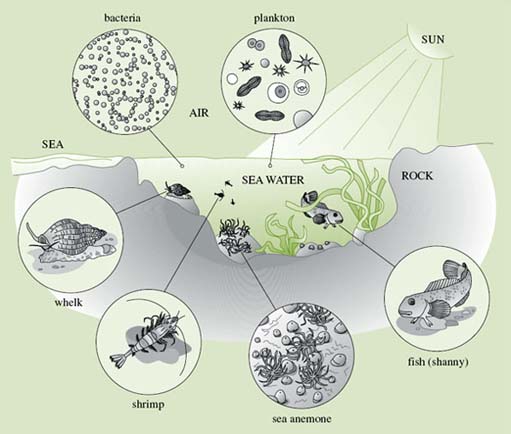2.2 An example ecosystem: the rockpool
Let's examine the concept of an ecosystem in more detail using an example that is familiar to many people: a rockpool on a British beach (see Figure 1).

Like all ecosystems, a rockpool is linked to the wider world and to other ecosystems. This link is most apparent in the shape of two tides every day, which change the sea water in the pool and bring in new organisms from the open ocean (as well as allowing others to escape back into the sea). The tides also change the physical characteristics of the pool and its surroundings. When the tide is out, the rockpool is a collection of organisms living together in a fairly clearly defined place. When the tide is in, the pool may become no more than a small depression on the rocky sea bed.
Now let's look at the components of our rockpool ecosystem in more detail. Remember, any ecosystem contains living things, a physical environment and a source of energy.
The most obvious living things will tend to be the largest ones: seaweeds, sea anemones, whelks, shrimps, fish and so on. But this shouldn't blind us to the importance of the organisms we can't see. For example, the water itself is full of tiny plants and animals – called ‘plankton’ – that are food for many of the larger creatures. And the water and rocks contain huge numbers of the simple single-celled organisms called bacteria, and other microscopic forms of life, that play an important part in the working of the ecosystem.
The most obvious components of the physical environment of the pool are the rock that surrounds it, the sea water in it, and the air above it (when the tide is out). But these physical factors are far from fixed. The tides, and the effect of sunlight on the exposed pool, mean that the organisms that live in it must be able to withstand changes and extremes of, for example, temperature or salt content. Some small pools dry up altogether in the summer or ice over in winter when the tide is out.
Almost all of the energy that supports the life in the pool arrives in the form of light from the sun. Some of this energy is captured by seaweeds attached to the rocks and microscopic plants (types of plankton). These plants are eaten by animals, which are eaten by other animals, and so on. But the sun is not the only source of energy involved in the workings of this particular ecosystem: the tides that sweep across the pool twice a day are driven up and down the beach by the gravitational pull of the moon.
Introducing energy
Energy is a concept that is used in many branches of science. In its everyday meaning, you may recognise it as the ‘ability’ to do something; whether that is movement, heating, lighting or providing food or fuel. These correspond to different forms of energy – kinetic (motion), thermal (heat), light, and chemical (food or fuel).
Energy can be converted from one form to another. For example, a plant converts sunlight into chemical energy. The energy from the food we eat (chemical energy) is used to keep us warm (heat energy), to enable us to move (kinetic energy) and to enable us to grow or put on weight (chemical energy in muscle and fat).
Although energy can go through many conversions, there is one rule that appears to apply everywhere in the universe. That is, energy cannot be created or destroyed – in any process, the total amount of energy is always constant.
Activity 4
Making notes
This section contains a lot of information. Did you do anything as you read it? Did you simply read the text, or did you make notes?
Read the description of the rockpool again. Try to pick out one or two of the main ideas in each paragraph.
Discussion
Here's my attempt.
Rockpool ecosystem – links to other ecosystems and wider world.
Ecosystem – living organisms, physical environment, energy.
Living things – plants, animals, plankton, bacteria.
Physical environment – rock, sea water, air, tides.
Energy – sunlight (also tides caused by pull of the moon).
Did you note many of the same points? Is there anything else you'd include? Is there anything you'd leave out? How did you set your notes out? Is there room for you to add extra information later on in your studies?
Remember that it is the observer – you or I – who defines an ecosystem, and selects which organisms or aspects of the environment to study. In much the same way, you have to decide what is important when you make notes.
However big or small our ecosystem, and whichever aspect of the system we choose to study, it is ecology that allows us to investigate how it works – and to wonder at the beauty and strangeness of it all.
